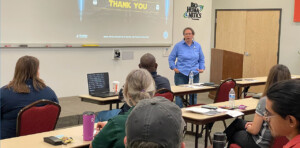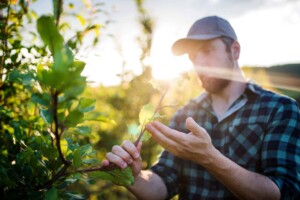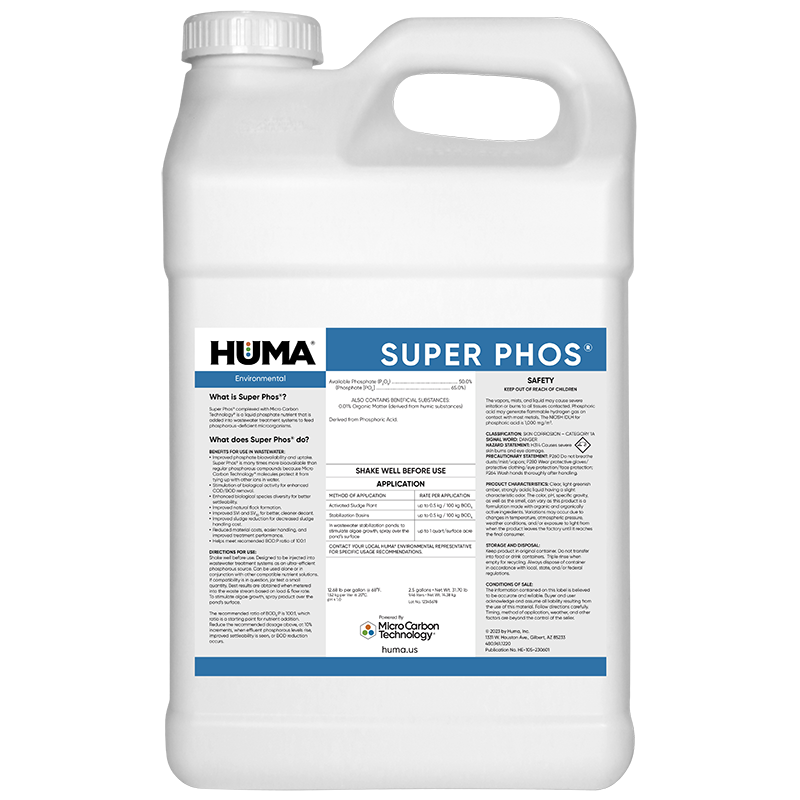Super Phos (HE)
Benefits of Use:
- Helps to meet BOD:P ratio of 100:1
- Improved phosphate bioavailability and uptake. Super Phos® is many times more bioavailable than regular phosphorous compounds because Micro Carbon Technology® molecules protect it from tying up with other ions in water.
- Stimulation of biological activity for enhanced COD/BOD removal.
- Enhanced biological species diversity for better settleability.
- Improved natural floc formation.
- Improved SVI and SV30 for better, cleaner decant.
- Decreased phosphate levels in the effluent stream. Because Super Phos® is more bioavailable less phosphorus is applied, resulting in lower discharges. Typically, one-fourth to one-tenth the amount of Super Phos® is used when compared with common-grade phosphoric acid nutrients.
- Reduced material costs, easier handling, and improved treatment performance.
Problem Conditions Improved:
- Formation of insoluble phosphorous precipitates
- Foaming caused by filamentous bacteria
- Excess sludge production
- Excess phosphorus levels in effluent
- Settleability concerns
- Tankage/Storage concerns
FAQs
Related Products
Related Case Studies

Super Phos® Lowers Papermill Operating Costs in China
Problem The existing wastewater treatment system uses 600 kg/day of diammonium phosphate (DAP) to provide the needed phosphorus concentration to maintain a healthy microbial population to treat wastewater. These microorganisms break down the organic matter being discharged from the paper processing facility. Without the correct concentration of available phosphorus, the microorganisms are unable to grow
Related Blog Posts

Get the “P” Out of There!
By Heather Jennings, PE Phosphorus is one of the most abundant elements on earth. It’s essential for adenosine triphosphate (ATP), the energy carrier life is built on. But in excess in our lakes and ponds, we see large algal growths occurring. Many times, these algal blooms suffocate the surrounding aquatic life and or produce toxins

PS and RWAAz Host PFAS Workshop
Probiotic Solutions®, along with the Rural Water Association of Arizona, conducted a workshop today on Per- and Polyfluoroalkyl Substances (PFAS) at Probiotic Solutions/Bio Huma Netics headquarters in Gilbert, Arizona. The workshop, titled “PFAS: The Phantom Menace,” featured presentations by Heather Jennings, PE, Director of Probiotic Solutions, and Marci Payne, Sales and Marketing Manager at Legend

BHN Sponsors Online Course on Sustainable Organic Agriculture Production
To help increase awareness about sustainable agriculture production, Bio Huma Netics, Inc., (BHN) is sponsoring a FarmProgress course for Certified Crop Advisers (CCAs) and Pest Control Advisers (PCAs) in the United States and Canada. This free online continuing education course, titled “Organic/Sustainable Agriculture Production -2022” aims to help working professionals learn about sustainable farming practices






